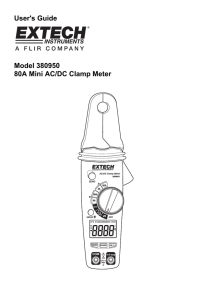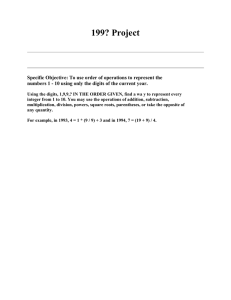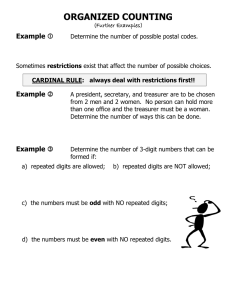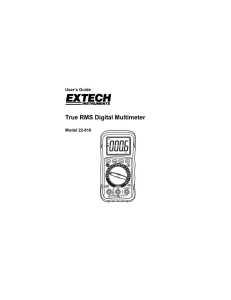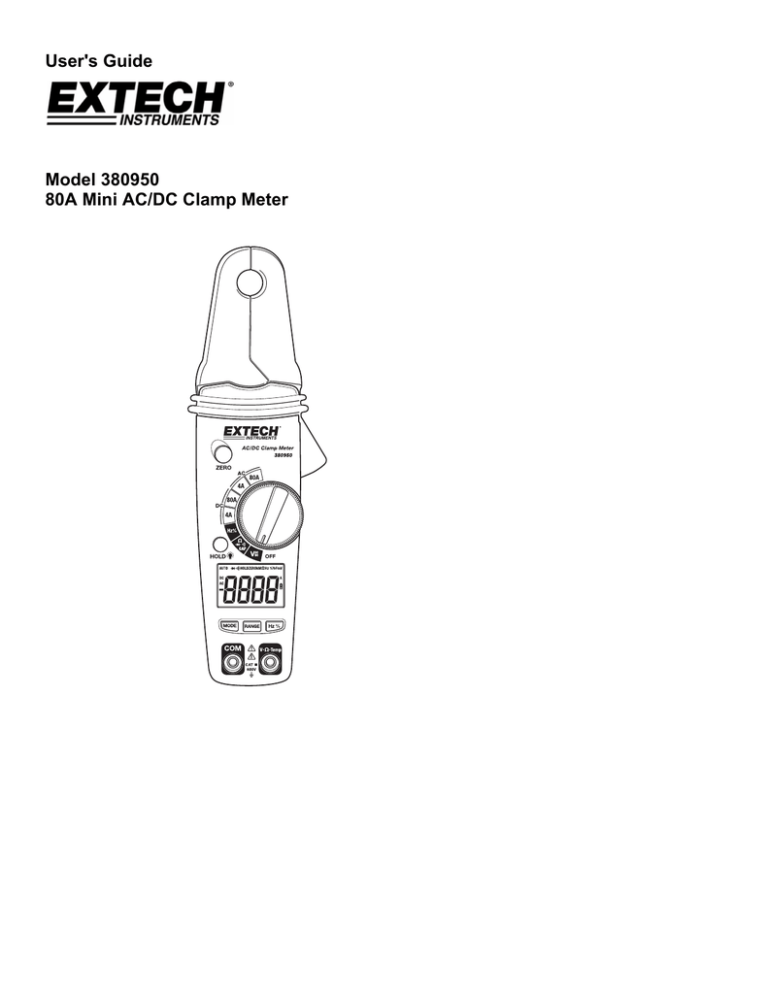
User's Guide
Model 380950
80A Mini AC/DC Clamp Meter
Introduction
Congratulations on your purchase of the Extech 80A Mini AC/DC Clamp Meter. The Model
380950 measures AC/DC Current, AC/DC Voltage, Resistance, Frequency, Capacitance,
Duty Cycle, Diode Test, and Continuity. This clamp meter is shipped fully tested and
calibrated and, with proper use, will provide years of reliable service.
Safety
International Safety Symbols
This symbol, adjacent to another symbol or terminal, indicates the user must refer
to the manual for further information.
This symbol, adjacent to a terminal, indicates that, under normal use, hazardous
voltages may be present
Double insulation
SAFETY NOTES
•
•
•
•
Do not exceed the maximum allowable input range of any function.
Do not apply voltage to meter when resistance function is selected.
Set the function switch OFF when the meter is not in use.
Remove the battery if meter is to be stored for longer than 60 days.
WARNINGS
•
•
•
•
Set function switch to the appropriate position before measuring.
When measuring volts do not switch to current/resistance modes.
Do not measure current on a circuit whose voltage exceeds 240V.
When changing ranges always disconnect the test leads from the circuit under test.
CAUTIONS
•
•
•
•
•
•
•
Improper use of this meter can cause damage, shock, injury or death. Read and
understand this user manual before operating the meter.
Always remove the test leads before replacing the battery or fuses.
Inspect the condition of the test leads and the meter itself for any damage before
operating the meter. Repair or replace any damage before use.
Use great care when making measurements if the voltages are greater than 25VAC
rms or 35VDC. These voltages are considered a shock hazard.
Always discharge capacitors and remove power from the device under test before
performing Diode, Resistance or Continuity tests.
Voltage checks on electrical outlets can be difficult and misleading because of the
uncertainty of connection to the recessed electrical contacts. Other means should be
used to ensure that the terminals are not "live".
If the equipment is used in a manner not specified by the manufacturer, the protection
provided by the equipment may be impaired.
Function
Maximum Input
A AC, A DC
80A DC/AC
V DC, V AC
600V DC/AC
Resistance, Frequency, Diode Test
250V DC/AC
2
380950 V1.0 6/07
Meter Description
1.
Conductor jaws
2.
Jaw opening trigger
3.
Function select switch
4.
LCD Display
5.
ZERO button
6.
Data Hold and Backlight Button
7.
Mode select button
8.
Range select button
9.
Hz/%/Duty Cycle button
10.
COM input jack
11.
V/Ω/Hz jack
12.
Battery cover (rear)
AC
AC (alternating current)
DC
DC (direct currrent)
Minus sign
AutoRange mode
ZERO mode
Audible Continuity
Data Hold mode
Low Battery icon
AUTO
ZERO
•)))
HOLD
m
V
A
K
M
Ω
Diode test mode
milli
Volts
Amps
kilo
Mega
Ohms
3
380950 V1.0 6/07
Operation
Notice: Read and understand all WARNING and CAUTION statements listed in the
safety section of this operation manual prior to using this meter. Set the function select
switch to the OFF position when the meter is not in use.
DC/AC Current Measurements
Warning: Disconnect the test leads from the meter before making
current clamp measurements.
1. Set the Function switch to the 80ADC, 4ADC, 80AAC or 4AAC
range. If the range of the measured is not known, select the
higher range first then move to the lower range if necessary.
2. For DC current measurement, press the ZERO key to null the
meter display.
3. Press the trigger to open jaw. Fully enclose one conductor to
be measured.
4. The clamp meter LCD will display the reading.
DC/AC Voltage Measurements
1. Set the rotary function switch to the V position.
2. Insert the black test lead banana plug into the negative (COM) jack
Insert the red test lead banana plug into the positive (V/Ω/Hz) jack
3. Select AC or DC with the MODE button
4. Connect the test leads to the circuit under test
5. Read the voltage on the display. The display will indicate the proper
decimal point and value.
Resistance Measurements
•))) CAP position.
1. Set the function switch to the Ω
2. Insert the black test lead banana plug into the negative (COM) jack
Insert the red test lead banana plug into the positive (VΩ Hz) jack.
3. Touch the test probe tips across the circuit or part under test. It is best to
disconnect one side of the part under test so the rest of the circuit will not
interfere with the resistance reading.
4. Read the resistance on the display. The display will indicate the proper
decimal point and value.
Continuity Check
•))) CAP position.
1. Set the function switch to the Ω
2. Push the mode button to indicate •))) on the display.
3. Insert the black lead banana plug into the negative (COM) jack
Insert the red test lead banana plug into the positive (VΩ Hz) jack.
4. Touch the test probe tips to the circuit or wire you wish to check.
5. If the resistance is less than approximately 150Ω, the audible signal will
sound. If the circuit is open, the display will indicate “OL.”.
4
380950 V1.0 6/07
Diode Test
•))) CAP position.
1. Turn the rotary switch to the Ω
2. Insert the black test lead banana plug into the negative (COM) jack
Insert the red test lead banana plug into the positive (VΩ Hz) jack.
3. Push the mode button to indicate
on the display.
4. Touch the test probes to the diode under test. Typically for a normal diode,
forward voltage will indicate 0.4V to 0.7V. Reverse voltage will indicate
“OL”. Shorted devices will indicate near 0V and an open device will indicate
“OL” in both polarities.
Capacitance Measurements
Warning: To avoid electrical shock, disconnect power to the unit under test and
discharge all capacitors before taking any capacitance measurements. Remove the
batteries and unplug the line cords.
1. Set the function switch to the Ω
•))) CAP position.
2. Push the mode button to indicate nF on the display.
3. Insert the black lead banana plug into the negative (COM) jack
Insert the red test lead banana plug into the positive (VΩHz) jack.
4. Press the ZERO key to null the meter display.
5. Touch the test probe tips to the capacitor you wish to check.
6. Read the capacitance value on the display.
Frequency or % Duty Cycle Measurements
1. Turn the rotary switch to the Hz % position.
2. Insert the black test lead banana plug into the negative (COM) jack and the
red test lead banana plug into the positive (VΩ Hz ) jack.
3. Select Hz or % with the HZ/% button.
4. Touch the test probe tips to the circuit under test.
5. Read the frequency on the display.
Analog Signal Output
1. Turn the rotary switch to the DCA or ACA ranges.
2. Insert the black test lead banana plug into the negative (COM) jack and the red test lead
banana plug into the positive (VΩ Hz) jack.
3. Connect the test leads to a multimeter, oscilloscope or chart recorder inputs.
4. Press the trigger to open the jaw. Fully enclose the conductor to be measured.
5. The analog voltage signal is output to the measuring device.
Note: When measuring DCA, the output signal is DCV. When measuring ACA, the output
signal is both ACV and DCV.
5
380950 V1.0 6/07
Auto/Manual Ranging
The meter turns on in Autoranging mode. Press the RANGE button to enter manual
ranging. Each press of the range button will step to the next range as indicated by the units
and decimal point location. Press and hold the RANGE button for two seconds to return to
Autoranging mode.
Note: Manual ranging does not function in AC Current or Diode and Continuity check
functions. In Temperature function, it will change the resolution from 0.1° to 1°.
Data Hold
To freeze the LCD meter reading, press the HOLD button. While data hold is active, the
HOLD display icon appears on the LCD. Press the HOLD button again to return to normal
operation.
Backlight
Press and hold the HOLD button for >2 seconds to turn the backlight on/off.
Note: The HOLD feature will activate when the backlight is turned on. Press the HOLD
button again to exit the Hold feature.
Zero Button
Zeros Capacitance and DC Current measurements. Also allows the user to offset the
meter by using the displayed value as the zero reference value. Press the ZERO key
momentarily to activate and to exit Zero mode.
6
380950 V1.0 6/07
Specifications
Function
DC Current
AC Current
(50/60Hz)
DC Voltage
AC Voltage
(50/60Hz)
Resistance
Capacitance
Frequency
Duty Cycle
Analog Output
(ACA & DCA
ranges)
Range & Resolution
Accuracy (of reading)
4.000 ADC
± (2.8% + 10 digits)
80.0 ADC
± (3.0% + 8 digits)
4.000 AAC
± (3.0% + 10 digits)
80.0 AAC
± (3.0% + 8 digits)
400.0mV
± (1.0% + 15 digits)
4.000V
± (1.0% + 3 digits)
40.00V
± (1.5% + 3 digits)
400.0V
600V
± (2.0% + 3 digits)
400.0mV
± (1.0% + 30 digits)
4.000V
40.00V
± (2.0% + 5 digits)
400.0V
600V
± (1.0% + 4 digits)
400.0Ω
4.000kΩ
± (1.5% + 2 digits)
40.00kΩ
400.0kΩ
± (2.5% + 3 digits)
4.000 MΩ
± (3.5% + 5 digits)
40.00MΩ
40.00nF
± (5% + 30 digits)
400.0nF
± (3% + 5 digits)
4.000µF
± (3.5% + 5 digits)
40.00µF
100.0µF
± (5% + 5 digits)
5.000Hz
± (1.5% + 5 digits)
50.00Hz
500.0Hz
5.000KHz
± (1.2% + 2 digits)
50.00KHz
Sensitivity: 10Vrms min.
500.0KHz
5.000MHz
10.00MHz
0.5% to 99.0%
± (1.2% + 2 digits)
Pulse Width: 100µs-100ms, Frequency: 5Hz to 150KHz
10mV/Amp ; Accuracy: ± (5%rdg + 2mV);
Output impedance: approx 3kΩ
7
380950 V1.0 6/07
Jaw size
0.5" (12.7mm) approx.
Display
4000 count LCD
Continuity
Audible tone < 150Ω approx.
Diode Test
Open circuit voltage < 1.5VDC; Test current <1mA (typical)
AC V bandwidth
50Hz to 400Hz
AC A bandwidth
50/60Hz
Low battery indication
“ ” is displayed
Overrange indication
“OL” is displayed
Auto Power OFF
After 25 minutes
Measurement rate
2 per second, nominal
Input Impedance
7.8MΩ (V DC and V AC)
Operating Temperature
14ºF to 122ºF (-10ºC to 50ºC)
Storage Temperature
-22 F to 140 F (-30 C to 60 C)
Operating Humidity
Max 80% up to 87ºF (31ºC) decreasing linearly to 50% at
113ºF(45ºC)
Storage Humidity
<80%
Operating Altitude
6560ft. (2000meters) operating
Batteries
(2) 1.5V AAA batteries
Weight
0.44lb (200g)
o
o
o
o
Size
7.87” x 1.97” x 1.38” (200x50x35mm)
Safety
For indoor use and in accordance with the requirements for
double insulation to IEC1010-1 (1995): EN61010-1 (1995)
Overvoltage Category III, Pollution Degree 2.
PER IEC1010 OVERVOLTAGE INSTALLATION CATEGORIES
OVERVOLTAGE CATEGORY I
Equipment of OVERVOLTAGE CATEGORY I is equipment for connection to circuits in
which measures are taken to limit the transient overvoltages to an appropriate low level.
Note – Examples include protected electronic circuits.
OVERVOLTAGE CATEGORY II
Equipment of OVERVOLTAGE CATEGORY II is energy-consuming equipment to be
supplied from the fixed installation.
Note – Examples include household, office, and laboratory appliances.
OVERVOLTAGE CATEGORY III
Equipment of OVERVOLTAGE CATEGORY III is equipment in fixed installations.
Note – Examples include switches in the fixed installation and some equipment for
industrial use with permanent connection to the fixed installation.
OVERVOLTAGE CATEGORY IV
Equipment of OVERVOLTAGE CATEGORY IV is for use at the origin of the installation.
Note – Examples include electricity meters and primary over-current protection equipment
8
380950 V1.0 6/07
Maintenance
WARNING: To avoid electrical shock, disconnect the meter from any circuit, remove the
test leads from the input terminals and turn OFF the meter before opening the case. Do
not operate with open case.
Cleaning and Storage
Periodically wipe the case with a damp cloth and mild detergent; do not use abrasives or
solvents. If the meter is not to be used for periods of longer than 60 days, remove the
batteries and store them separately
Battery Replacement
1. Remove the two rear battery cover Phillips head screws
2.
Open the battery compartment
3.
Replace the two 1.5V AAA batteries.
4.
Re-assemble the meter
Warranty
EXTECH INSTRUMENTS CORPORATION warrants this instrument to be free of defects
in parts and workmanship for one year from date of shipment (a six month limited warranty
applies to sensors and cables). If it should become necessary to return the instrument for
service during or beyond the warranty period, contact the Customer Service Department at
(781) 890-7440 ext. 210 for authorization or visit our website www.extech.com for contact
information. A Return Authorization (RA) number must be issued before any product is
returned to Extech. The sender is responsible for shipping charges, freight, insurance and
proper packaging to prevent damage in transit. This warranty does not apply to defects
resulting from action of the user such as misuse, improper wiring, operation outside of
specification, improper maintenance or repair, or unauthorized modification. Extech
specifically disclaims any implied warranties or merchantability or fitness for a specific
purpose and will not be liable for any direct, indirect, incidental or consequential damages.
Extech's total liability is limited to repair or replacement of the product. The warranty set
forth above is inclusive and no other warranty, whether written or oral, is expressed or
implied.
Calibration and Repair Services
Extech offers repair and calibration services for the products we sell. Extech also provides
NIST certification for most products. Call the Customer Care Department for information on
calibration services available for this product. Extech recommends that annual calibrations
be performed to verify meter performance and accuracy.
Support line (781) 890-7440
Technical Support: Extension 200; E-mail: support@extech.com
Repair & Returns: Extension 210; E-mail: repair@extech.com
Product specifications subject to change without notice
For the latest version of this User’s Guide, Software updates, and other
up-to-the-minute product information, visit our website: www.extech.com
Extech Instruments Corporation, 285 Bear Hill Rd., Waltham, MA 02451
Copyright © 2007 Extech Instruments Corporation
All rights reserved including the right of reproduction in whole or in part in any form.
9
380950 V1.0 6/07

